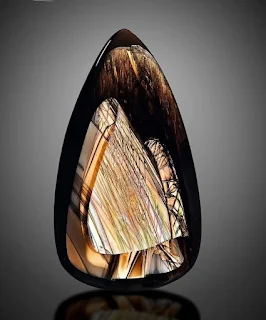Fire obsidian is unlike any gemstone you’ve ever seen. With vibrant flashes of color that ripple like flames beneath its glassy surface, this rare volcanic glass captures light—and imaginations—like no other. Found only in one remote area of the world, fire obsidian is prized for its natural iridescence and mesmerizing depth. But what makes it so special? Let’s dive into the fiery facts behind this collector’s dream.
What Is Fire Obsidian?
Fire obsidian is a type of iridescent volcanic glass found only in the Steens Mountain Wilderness of southeastern Oregon. Unlike typical black obsidian, this rare variety shows flashes of red, orange, yellow, green, and even blue—colors caused by microscopic layers of magnetite embedded within the stone. These layers interact with light, creating the shifting rainbow effect that gives fire obsidian its name.
How It Forms
This stunning stone formed 4 to 5 million years ago during the cooling of a rhyolite lava dome. The lava cooled so quickly that it formed volcanic glass—obsidian. But here’s the twist: the presence of thin magnetite layers, just microns thick, gave rise to the fiery iridescence. The phenomenon is similar to the optical effects seen in butterfly wings or peacock feathers—only this one formed deep within the Earth.
 |
| Photo Copyright Tom Dodge |
Where to Find It
You won’t find fire obsidian just anywhere. In fact, it’s only known to occur in one location in the world: a series of thin dikes in the Steens Mountain area of Oregon.
 |
| Photo Copyright Tom Dodge |
The obsidian seams are narrow and difficult to access, which makes fire obsidian incredibly rare and valuable. Most pieces on the market come from hand-mined, responsibly sourced areas of private or protected land.
Physical & Chemical Properties
-
Color: Red, orange, green, blue, yellow (iridescent play-of-color)
-
Hardness: 5–6 on the Mohs scale
-
Luster: Glassy
-
Transparency: Translucent to opaque
-
Density: 2.5–2.6 g/cm³
-
Composition: Mostly SiO₂ (silicon dioxide), with iron oxide (FeO) and magnetite for the color layers
-
Magnetism: Weakly magnetic due to iron content
-
Fracture: Conchoidal, with smooth, curved break patterns
Its unique pleochroism—a subtle color change depending on viewing angle—adds to its allure, especially in polished cabochons.
 |
| Photo Copyright Tom Dodge |
Value and Rarity
Because it comes from a single location and requires expert cutting to bring out its full visual potential, fire obsidian can command high prices. Top-quality cabochons or rough specimens showing full-spectrum iridescence can sell for hundreds—even thousands—of dollars. It is easily one of the most expensive types of obsidian in the world.
Uses of Fire Obsidian
Jewelry:
Its vibrant flashes make fire obsidian a favorite for cabochon cuts in rings, pendants, and bracelets. Each stone is unique, and the color play adds a mystical flair to any piece.
Carvings & Sculptures:
Artists carve fire obsidian into dramatic sculptures and talismans. The natural lines and swirls often guide the design, turning rough stone into shimmering firebirds, dragons, or abstract shapes.
Metaphysical Uses:
-
Protection: Believed to shield against negativity and psychic attacks
-
Transformation: Represents inner growth, rebirth, and self-realization
-
Fire Energy: Used in practices that seek to ignite creativity and passion
Decorative Art:
Fire obsidian finds its way into functional art such as lamp bases, coasters, bookends, and mosaic tiles—making even everyday objects magical.
What Makes It Glow?
 |
| Photo Copyright Tom Dodge |
The iridescence in fire obsidian isn’t just surface-deep. It comes from ultra-thin magnetite layers that refract light similarly to oil slicks or soap bubbles. The layers are so thin—just a few microns thick—that they manipulate light at a microscopic level, splitting it into colors based on angle and wavelength. This natural optical magic is what gives fire obsidian its fiery glow.
Is It Natural or Treated?
 |
| Photo Copyright Tom Dodge |
Fire obsidian is a completely natural gemstone. Its play-of-color is not the result of dyeing or treatment—only precise polishing techniques are used to enhance the natural iridescence. As always, it’s wise to buy from reputable dealers who can confirm the stone’s origin and authenticity.



